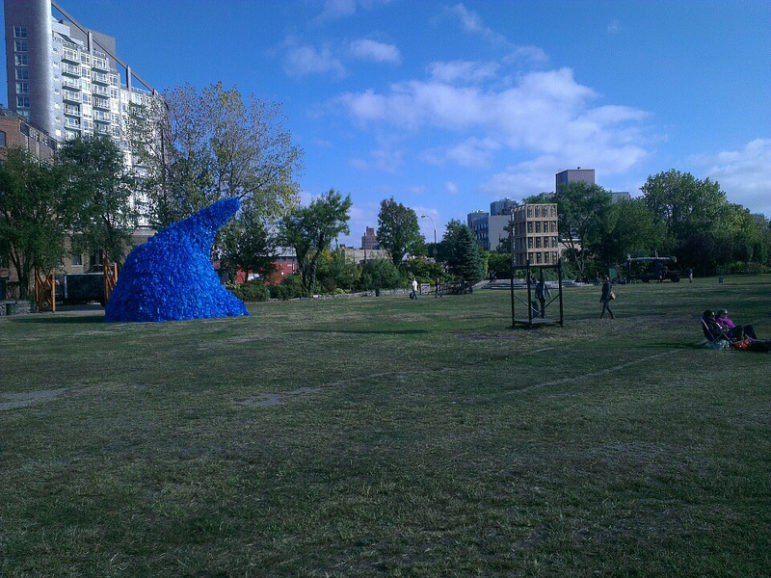
June 24, 2016; Philadelphia Inquirer and Next City
In Long Island City, Queens, the 30th anniversary of Socrates Sculpture Park, a former landfill and docking area, is being marked with a multi-artist installation titled “Landmark,” which Next City describes as an exhibition “that wrestles with issues of legacy, land use and ownership.” A hundred miles south, a group of Philadelphia sculptors installed a series of temporary works in an old military vessel, the cruiser Olympia. The ship is managed by and floats alongside of Independence Seaport Museum. For the duration of this exhibition, the ship is dubbed the “Artship Olympia,” as reported in the Philadelphia Inquirer.
The Olympia is a National Historic Landmark Ship. It launched in 1892 and was decommissioned in 1922. The ship served in 1898 as Admiral George Dewey’s flagship in the Battle of Manila Bay during the Spanish-American War. For this exhibition, which features the work of 17 artists from the nonprofit Philadelphia Sculptors, “the cruiser Olympia has been overtaken by a spell of delirium,” according to Inquirer reporter, Samantha Melamed. “The officers’ washroom has become a mustache-themed funhouse featuring every style and texture of facial hair. Ghostly crewmen flicker in the sick bay, lockets appear to float through a stateroom, and, in the sailors’ quarters, hammocks of almost invisible monofilament levitate like departing souls.” Not to mention the 30 crocheted rats, and She-Sea, “a meditation on the mythology of the ocean as a feminine force,” with “rolling waves of netting, overlaid with projections of dresses and hair and a Sirenlike audio track.”
As Philadelphia Sculptors’ president Leslie Kaufman explains, “The idea is to bring new attention to the ship and to bring a new audience of artists and art lovers.” The Olympia has been under the care of Independence Seaport Museum since 1996. The museum is in the planning stages of a fundraising campaign for restoration and infrastructure that is expected to cost $15 to $20 million. The museum’s goal is to raise awareness of the importance of the historical significance of Olympia. As museum president & CEO John Brady explains, “Over the years, I don’t think enough has been done to popularize the ship, and this is a move in that direction.”
Sign up for our free newsletters
Subscribe to NPQ's newsletters to have our top stories delivered directly to your inbox.
By signing up, you agree to our privacy policy and terms of use, and to receive messages from NPQ and our partners.
Back in the 1980s, Socrates Sculpture Park was an abandoned lot that was being used as a dumping site until artist Mark di Suvero, whose studio was nearby, began a grassroots effort to clean up the space and make it a haven for artists and neighbors alike. What began as an all-volunteer effort eventually morphed into a nonprofit, which now has a license agreement with New York City to maintain and operate the space as a public park. As reported by Jen Kinney in Next City, “Socrates now runs an employment program with landscaping company Plant Specialists. Residents of the Astoria House public housing complex are hired as grounds crew, learning basic job skills and horticulture. If it goes well Plant Specialists hires them full-time.” The park also screens international films during the summer and offers healthy living programs, including exercise classes and a green market.
Sculpture featured in the “Landmark” exhibition include a shipwreck, a beehive installed in a salvaged piano, and “a cotton picker and a football player facing off across a white line on a darkened field.” A large “earthwork” by Meg Webster named Concave Room for Bees is a raised garden bed with walls of dirt five feet high and filled with plants that attract pollinators. After the exhibition ends in late August, the 300 cubic feet of dirt will be scattered across the park, helping to enrich the soil, which is still of poor quality because of the site’s history as a landfill.
As Kinney explains, “Landmark” offers “an oblique commentary on the park’s role as witness and partner in the transformation of Long Island City, Queens.” New condominium developments are spreading throughout the area, which is home to the largest public housing complex in the country. “Landmark” does not impede real estate development, but it does reference the history of the place. For example, Abigail DeVille’s shipwreck sculpture, Half Moon, named for Henry Hudson’s boat, hints at questions of colonization and gentrification. And Jessica’s Segall’s Fugue in B flat, the salvaged piano abuzz with bees, is a nod to the changing nature of Queens, which “was once a center of industry, known in particular for piano manufacturing,” but is now largely residential.
Both exhibitions underscore just how eclectic contemporary sculpture has become—and how varied its materials are. Both also animate history in fresh ways, inviting visitors into two very different conversations.—Eileen Cunniffe













